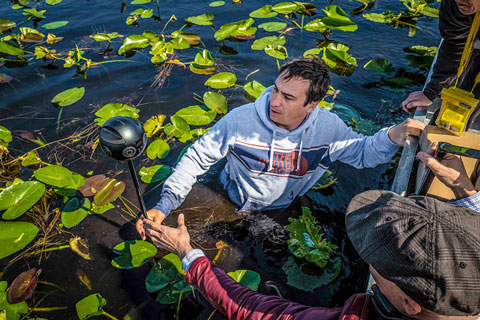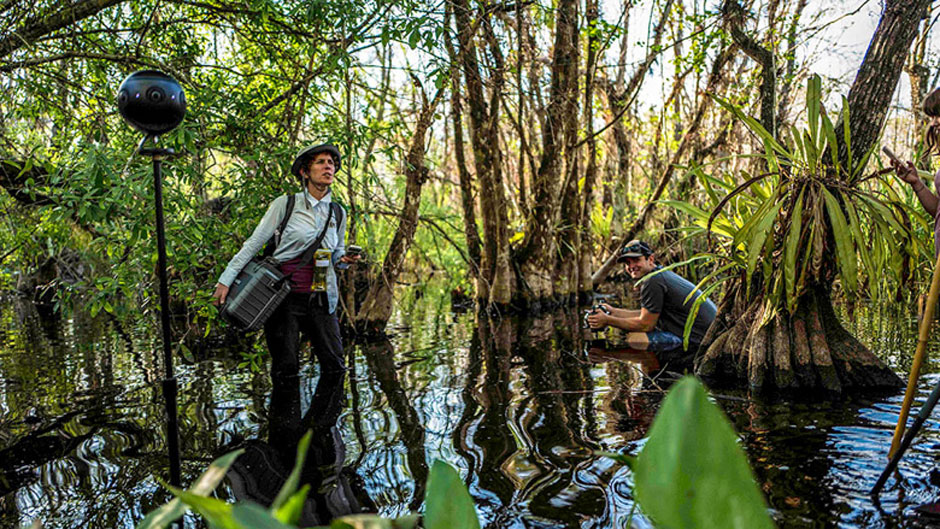As South Floridians, we boast beautiful beaches and tropical temperatures, but often fail to acknowledge the sweeping beauty of the Florida Everglades. As the earth undergoes accelerated change, understanding the landscape’s function in human and ecologic survival is essential.
Former Visiting Knight Chair Liz Miller, University of Miami School of Communication Associate Professor Kim Grinfeder and Miami-based filmmaker and artist Juan Carlos Zaldivar co-directed an immersive four-platform project designed to reconnect users with the importance of the swampland. Graduate and undergraduate Communication students enrolled in Miller’s and Grinfeder’s classes also contributed to the multi-faceted production.
“I had just completed a three-year i-doc on global shorelines and I felt that the story of swamps was largely absent from discussions around climate challenges and solutions,” said Miller. “I was also in close proximity to the Everglades and was eager to immerse myself in the area.”
The team did just that. Whether working within classrooms or the depths of the Fakahatchee Swamp in the Everglades, the varied components of SwampScapes came to fruition through the diverse skillsets involved. Student collaborators, whose specialties range from interactive design to photography, benefited from both continuous support and the freedom to work autonomously.
“I really appreciated the balance between guided direction and creative freedom that was allowed on our shoots,” said Evan Karge, a graduate student with experience filming underwater. “Because I am relatively new to videography, I was hoping to get some specific structure and feedback to have some sort of framework to be able to put together compelling shots, but I also feel as though I have this skill, especially in the underwater realm and I felt as though I was able to exercise my own creativity.”
Each region of the Florida Everglades explored in SwampScapes includes a “local guide,” ranging from artists to biologists. These passionate protectors of Florida’s wetlands are represented through still photographs, 2D videos on the website, and an original virtual reality (VR) linear film presented at festivals, connecting the project’s four platforms: SwampScapes’ website, VR linear film, interactive VR documentary and photo installation.
The four prongs are intended to bring much-needed attention to the disappearing swamps, as well as to understand the most effective approaches to educating users.

“I want the viewers to understand the delicate and interlinked nature of the Everglades,” said Grinfeder. “As humans, we need to be conscious of our footsteps in such an environment.”
The Center for Communication, Culture and Change provided and administered the funding for the project, including access to technology and facilities at the SoC for production.
“Recruiting Professor Miller to be our visiting Knight Chair was a wise choice,” said Konstantia Kontaxis, director of the Center for Communication, Culture, and Change. “The Center, and by extension the School, was able to resource such a large collaborative project and complete it within the scope of a semester and a few extra months, which is a testament to the capacity of the Center and the School to take on such complex projects. More than anything else it proves that our School’s faculty, students, and staff process the necessary knowledge and talent for distinction in media innovation.”
The SwampScapes team was awarded first place in VR Films in the Tacoma Film Festival. Additionally, the project was a featured installation at GEMs, an extension of the Miami Film Festival.
The most exciting achievement of the project? Spreading swamp literacy.
“Our main goal is to use the project to build awareness so we see this as the beginning of a much longer path,” said Miller.
Meet the guardians of the Everglades and explore its complexities with SwampScapes.

